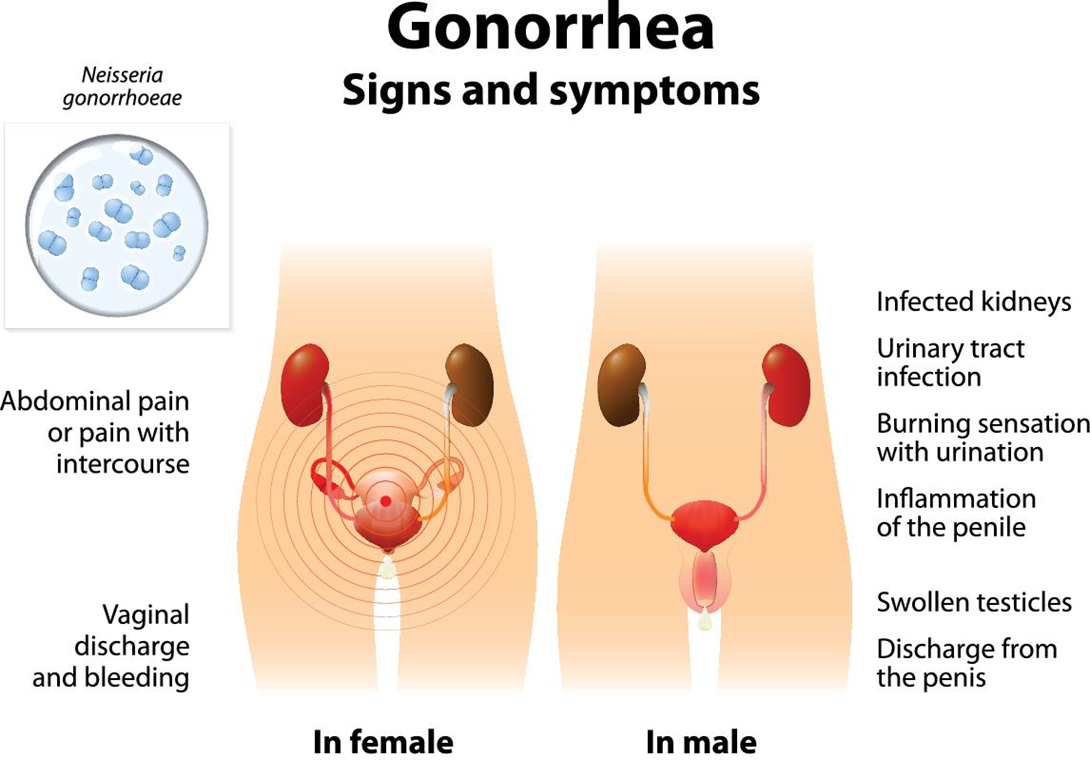Which of the following sexually transmitted infections is caused by a bacterium called Neisseria gonorrhoeae, often produces no symptoms, but can be treated with antibiotics? If symptoms occur, they may include painful urination and discharge from the penis or vagina. If left untreated, the infection can result in more serious long-term problems, including infertility, pain, and joint problems.
Human papillomavirus
Gonorrhea
Herpes simplex virus
Cytomegalovirus
The Correct Answer is B
Choice A reason: Human papillomavirus is incorrect because it is not caused by a bacterium, but by a virus. It can cause genital warts and cervical cancer, but it cannot be cured with antibiotics.
Choice B reason: Gonorrhea is correct because it is caused by a bacterium called Neisseria gonorrhoeae, often produces no symptoms, but can be treated with antibiotics. If symptoms occur, they may include painful urination and discharge from the penis or vagina. If left untreated, the infection can result in more serious long-term problems, including infertility, pain, and joint problems.
Choice C reason: Herpes simplex virus is incorrect because it is not caused by a bacterium, but by a virus. It can cause genital herpes, which is marked by painful blisters and sores in the genital area. It cannot be cured with antibiotics, but antiviral medications can help reduce the frequency and severity of outbreaks.
Choice D reason: Cytomegalovirus is incorrect because it is not caused by a bacterium, but by a virus. It usually causes mild or no symptoms in healthy people, but can be serious in people with weakened immune systems or unborn babies. It cannot be cured with antibiotics, but antiviral medications can help treat the symptoms.

Nursing Test Bank
Naxlex Comprehensive Predictor Exams
Related Questions
Correct Answer is B
Explanation
Choice A reason: Hyperbilirubinemia is incorrect because it is not a major complication of infants of diabetic mothers. It is a condition where the baby has high levels of bilirubin in the blood, which can cause jaundice. It can occur in any newborn, but it is more common in premature babies, babies with blood type incompatibility, or babies with infections.
Choice B reason: Hypoglycemia is correct because it is a major complication of infants of diabetic mothers. It is a condition where the baby has low blood sugar levels, which can cause seizures, lethargy, or poor feeding. It can occur because the baby's pancreas produces too much insulin in response to the mother's high blood sugar levels during pregnancy.
Choice C reason: Hypoinsulinemia is incorrect because it is not a major complication of infants of diabetic mothers. It is a condition where the body does not produce enough insulin, which can cause high blood sugar levels. It can occur in children or adults with type 1 diabetes, but not in newborns of diabetic mothers.
Choice D reason: Hypercalcemia is incorrect because it is not a major complication of infants of diabetic mothers. It is a condition where the baby has high levels of calcium in the blood, which can cause muscle weakness, vomiting, or kidney stones. It can occur in babies with certain genetic disorders, such as Williams syndrome, or babies with hyperparathyroidism, but not in infants of diabetic mothers.
Correct Answer is D
Explanation
Choice A reason: Fresh fruits are incorrect because they are not rich sources of iron. They are good sources of vitamin C, which can enhance iron absorption, but they do not provide enough iron by themselves.
Choice B reason: Milk and cheese are incorrect because they are not rich sources of iron. They are good sources of calcium, which is important for bone health, but they can interfere with iron absorption if consumed in excess.
Choice C reason: Whole grain breads are incorrect because they are not rich sources of iron. They are good sources of complex carbohydrates, which provide energy and fiber, but they contain phytates, which can inhibit iron absorption.
Choice D reason: Red meat and organ meats are correct because they are rich sources of iron. They contain heme iron, which is more easily absorbed by the body than non-heme iron from plant sources. They also provide protein, which is essential for tissue growth and repair.

Whether you are a student looking to ace your exams or a practicing nurse seeking to enhance your expertise , our nursing education contents will empower you with the confidence and competence to make a difference in the lives of patients and become a respected leader in the healthcare field.
Visit Naxlex, invest in your future and unlock endless possibilities with our unparalleled nursing education contents today
Report Wrong Answer on the Current Question
Do you disagree with the answer? If yes, what is your expected answer? Explain.
Kindly be descriptive with the issue you are facing.
